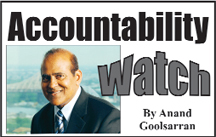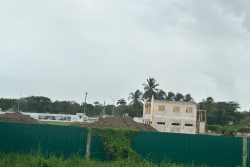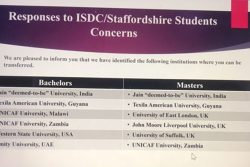Last week, we carried our second article highlighting the key findings and recommendations contained in the International Monetary Fund (IMF) report entitled “Guyana: A reform Agenda for Petroleum Taxation and Revenue Management” dated November 2017. Today, we conclude our analysis of the report and highlight the remaining findings and recommendations for the benefit of our readers.
Chapter II: Fiscal regimes for extractive industries (cont’d)
Mining sector fiscal issues
 Artisanal miners pay a flat rate of five percent on the gross value of gold production, while for large scale miners the royalty is on a per ounce basis using the world market price for gold – five percent under US$1,000 and eight percent above US$1,000. The current royalty system ignores the profitability of individual mines. A preferred option is a combination of royalty and a mining rent tax. The latter is based on an additional tax on profitability beyond a prescribed threshold. In addition, mining businesses that obtain tariff and Value Added Tax (VAT) exemptions on imports favour foreign suppliers over domestic ones, thereby creating competitive imbalances and administrative complexities. Companies also experience significant delays in the processing of their annual investment development agreements to import equipment under contractually granted exemption.
Artisanal miners pay a flat rate of five percent on the gross value of gold production, while for large scale miners the royalty is on a per ounce basis using the world market price for gold – five percent under US$1,000 and eight percent above US$1,000. The current royalty system ignores the profitability of individual mines. A preferred option is a combination of royalty and a mining rent tax. The latter is based on an additional tax on profitability beyond a prescribed threshold. In addition, mining businesses that obtain tariff and Value Added Tax (VAT) exemptions on imports favour foreign suppliers over domestic ones, thereby creating competitive imbalances and administrative complexities. Companies also experience significant delays in the processing of their annual investment development agreements to import equipment under contractually granted exemption.
The IMF team believes that a comprehensive review of the mining tax regime would provide a good basis for introducing a generally applicable fiscal regime for future investments in mining.
Petroleum revenue administration
The exploration and development phase of petroleum extraction typically covers a time-span of five or more years. Since the related expenditures will be charged against future revenue, the tax authorities need to start monitoring and auditing these expenditures. It is not so much about the number of staff but more the particular skills needed to undertake these activities. ExxonMobil estimates the cost to develop phase 1 of the Liza field at US$4.4 billion.
The Minister responsible for petroleum is responsible for preparing and filing the tax returns of the contractor. However, guidance is needed on how to calculate the tax liability of a company holding an interest in Production Sharing Agreement (PSA). In addition, plans to establish a petroleum industry taxpayer unit attached to the Guyana Revenue Authority should be prioritized.
The IMF team has made the following recommendations:
(a) Draft a practice note on the implementation of the “pay-on-behalf’ scheme in consultation with existing PSA holders;
(b) Establish formal and structured working relationships on responsibilities between agencies having a regulatory responsibility for the petroleum sector; and
(c) Appoint the GRA as the single collection agency for PSA, royalty, and petroleum tax revenue; and
(d) Continue to build capacity in petroleum tax administration.
Chapter III: Extractive industries revenue management
Macro-fiscal framework
Several specific challenges relating to revenue management in extractive industries have been identified. These include:
(a) Revenue can be potentially large but temporary, given the exhaustibility of the natural resources;
(b) Revenue can be volatile and uncertain;
(c) Government spending is often procyclical, that is, it increases in lock-step with the extractive in-dustry revenue;
(d) There is often the pressure to increase government spending upfront, sometimes by borrowing against future expected revenue; and
(e) These spending pressures often arise from elevated expectations from citizens as to the benefits from extractive industries projects.
The above challenges can be addressed by designing a fiscal policy framework that reflects a balance between increasing investments in development projects on the one hand, and the need to set aside funds for stabilization and future generations, on the other. The first step is to calculate the total government wealth derived from oil. The Liza field assumes that 450 barrels of oil will be extracted over a 20-year period, estimated to generate government revenue of US$4.561 billion in real terms and taking account time value of money. Given the
uncertainties involved in terms of future oil prices, production volumes and costs, it would be prudent to come up with a range of government wealth estimates under different scenarios.
The second step is to calculate the sustainable income generated from the oil wealth which is a notional measure of the return – the actual long run average return on financial savings. The report estimates the sustainable income from the initial oil wealth at US$137 million annually in real terms. This is the amount of oil revenue that can be spent annually, while preserving the total government wealth from oil indefinitely. The third step is to repeat the calculation for each year throughout the planning horizon. Oil revenue produced in any given year above the estimated sustainable income will be saved in the form of financial assets. Over time, this implies that the government wealth from future revenue from oil in the ground will be converted into financial assets.
The IMF team has made the following recommendations:
(a) Prepare a policy paper setting out a macro-fiscal framework;
(b) Consider introducing a fiscal responsibility bill incorporating the macro-fiscal framework;
(c) After incorporating oil revenue into the medium-term macro-fiscal framework, start using the non-oil balance as an indicator of the fiscal stance;
(d) As oil revenue is incorporated into the macro-economic framework, prepare annual estimates of the sustainable income from oil applying the permanent income hypothesis (PIH) benchmark to oil revenues from fields in production or in development with a production licence;
(e) Integrate a revenue forecasting model into the macro-fiscal framework; and
(f) Formulate, design and calibrate a flexible fiscal rule, with minimal discretion that meets the policy objectives of: (i) no initial borrowing against future oil revenue; (ii) gradual scaling up during the peak production period; and (iii) eventually transitioning toward a PIH rule in the long run.
Public financial management
The report credited Guyana for achieving good progress in implementing Public Financial Management (PFM) reforms, including: (i) approval of the 2017 budget before the start of the fiscal year; (ii) gradual implementation of programme and results-based budgeting; (iii) developing a medium-term perspective in the budget; (iii) publishing a comprehensive mid-year review of the budget; and (iv) the timely completion and publishing of audited financial statements. However, sustaining the reform agenda has proved increasingly challenging with limited capacity in the Ministry of Finance and line agencies. With the discovery of petroleum, the challenge is even greater to have in place strong PFM systems.
The IMF Team reviewed key aspects of the PFM systems, including: strategic planning; medium-term fiscal and budget frameworks; public investment management; annual budget formulation and execution; fiscal risk management; and capacity building. Based on the review, the following recommendations were made:
(a) Finalise a strategic plan for 2017-2021;
(b) Prepare and/or update sectoral strategies for major sector to guide the medium- term budgeting;
(c) Through strategic planning, identify a limited number of strategic, transformative public investment projects;
(d) Develop and publish a medium-term fiscal strategy to anchor and guide the budget;
(e) Develop capacity to prepare a credible medium-term budget framework with aggregate revenue, expenditure and financing assumptions;
(f) Improve the management of the public investment programme and ensure full integration into the annual and medium-term budget process;
(g) Strengthen annual budget formulation, including preparation of overall resource envelope and ministerial/ programme ceilings, and approval of envelope and ceilings by the Cabinet;
(h) Improve budget documentation to facilitate informed discussion of expenditure policies and priorities, and ensure the budget is in line with agreed priorities and medium-term fiscal aggregates;
(i) Develop a strategy for strengthening treasury functions, including preparations for establishing a Treasury Single Account;
(j) Strengthen cash management capacity, expenditure controls and internal audit function;
(k) Analyse the gaps between current government accounting policies and cash-basis International Public Sector Accounting Standard (IPSAS), and develop a cash-basis IPSAS reform strategy and roadmap;
(l) Review and update PFM-related legislation, rules and procedures to reflect management of revenues from natural resources;
(m) Develop a framework to monitor main fiscal risks and start preparing a fiscal risk statement, including assessing risks to revenue from extractive industries, to be submitted with the budget documentation;
(n) Strengthen a framework for monitoring and providing oversight of statutory bodies and public enterprises;
(o) Examine the present approach to reform implementation to ensure PFM reforms are coordinated across the spectrum of required actions;
(p) Consider creating a reform unit/group in the Ministry of Finance to coordinate the PFM reforms; and
(q) Develop a training programme on PFM systems to ensure continuous capacity building in line agencies and statutory bodies.
Natural resource fund draft legislation
The Government has prepared draft legislation for the establishment of a natural resource fund, also known as a Sovereign Wealth Fund. Such a fund cannot be viewed in isolation of the general policy and PFM framework. Rather it should be well-integrated to enhance transparency and credibility of fiscal policy or budget framework. In this regard, it would be preferable to have either a separate fiscal responsibility legislation or integrate such responsibility into the Fiscal Management and Accountability (FMA) Act. The fund also plays a key role in the management of financial assets for the government.
Of foremost importance is the need to ensure that deposit/withdrawal rules for the natural resource fund are consistent with the fiscal rule in the fiscal policy framework. It is also preferable for the fund to be used to finance the budget deficit, and with no separate spending authority. In other words, all spending, whether financed by general revenue or from withdrawals from the natural resource fund, should be done through the regular budget involving parliamentary expenditure prioritization, scrutiny and oversight.
Chapter IV: Roadmap for petroleum sector reforms
The Government is facing significant challenges in preparing for the start of oil production. With efforts underway simultaneously across multiple fronts, there is a need for strong leadership. In this regard, it may be helpful not only to prepare a roadmap of reforms and changes necessary between now and the start of production but also to coordinate technical assistance to ensure that all gaps are covered, and duplication of efforts is avoided.
The IMF team has proposed a roadmap in the form of a table showing the key objectives; issues and tasks; timeframe for implementation; the lead agency responsible; and any technical support that would be needed. The roadmap is in effect a summarization of the key issues raised in the report in tabular form, with insertion of timeframes for the implementation of each recommendation.
Chapter V: Possible technical assistance and capacity building
The IMF team referred to the inclusion of Guyana in the multi-donor trust fund on Managing Natural Resource Wealth (MNRW) which provides support in the delivery of technical assistance and capacity building to better manage and benefit from natural resources. A possible project for Guyana could focus on: (i) fiscal regime and revenue forecasting; and (ii) macro-fiscal framework and PFM systems.
Appendices to the report
There are three appendices to the report: Appendix 1 – Fiscal terms of international comparators focusing on the practices in Australia, Brazil, Colombia, Norway, Peru, Trinidad and Tobago, and the United States; Appendix II – Comments on the draft National Resource Fund Act; and Appendix III – Preliminary comments on the Petroleum Commission Bill.
Next week, we will examine the draft legislation on the Sovereign Wealth Fund and the proposed establishment of the Petroleum Commission.









